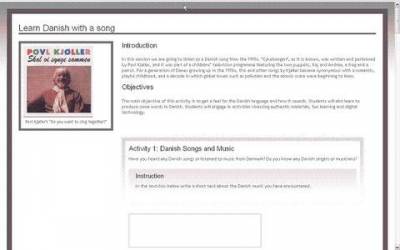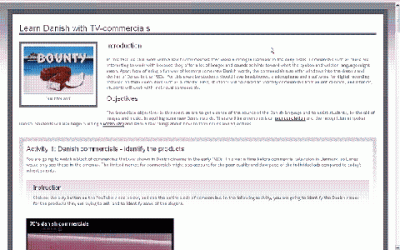Digital Learning Objects
Created by Jakob Stougaard-Nielsen
The Danish digital learning objects were created with the LOC tool (Learning Object Creator) developed by the LLAS Subject Centre in collaboration with the University of Southampton eLanguages group. According to the LLAS website, the LOC tool is "a simple authoring tool for teachers, which has been specifically designed to enable teachers to create their own e-learning materials without the need for technical support or training". The two learning objects created for this project have both been integrated into the VLE (Moodle) that is used in the Basic Danish course at UCL , and are furthermore accessible from the CETL project Moodle site.
The materials are designed to introduce students, who have no prior knowledge of Danish to an interactive, immersive and fun way of learning the new sounds of Danish. The materials also intended to appeal to the learners' sense of similarities between languages, their imagination and creativity, and to their interest in Danish culture. While the materials may be used independently by students as a distance learning tool, since students receive immediate response after completing each activity, the materials are best used in a blended learning environment, where the tutor can assist and encourage the students, and an element of fun competition and shared experience between the students add to the learning experience.
Rationale
It goes without saying that this material intended as the first language material my students encounter in the Basic Danish course is a far cry from the tradition book based and newer web based materials available to learners of Danish as a foreign language. Most materials, either book or web based begin with very small units of language such as greetings and explaining where you are from to proceed to tackle larger units of communicative language useful when meeting Danes in very stylized situations.
These traditional materials perceive language as small units that will be fed to the students who will then, eventually, be able to put them together in larger more complex units substituting them for relevant units according to grammar and idiom. The materials created here are trying to turn this conception upside down by allowing learners to immerse themselves in authentic materials, and to produce language in all its complexity from the very beginning.
- Danish Learning Objects on Moodle (UCL login required)
Object 1: Learn Danish with a Song

The first object that was created for this project was inspired by Ian Newby's ideas for teaching a beginners class Spanish through a traditional song. For the Danish variant was chosen a song from the 1970's that most Danes know by heart as a children's song embedded in its own time. The song has a simple structure, a repetitive rephrain and includes simple vocabulary with many words that are recognizable for English speakers, and grammatical structures that are repeated from verse to verse.
This learning object was created to introduce first year students to the sounds of Danish. Students with no prior knowledge of Danish would usually not encounter "authentic" material such as this in their first week as Danish learners. The material allows the students to make use of their knowledge of languages and their senses in order to make sense of the words of the song.
They are asked to listen for instruments that reveal something about the song's feel and content, they are asked to make associations from visual materials and to discuss why certain images may relate to the song, and they are asked to use their knowledge of grammatical structures in Germanic languages, and of words that are similar in Danish and English, to make sense of the song's verses. Furthermore, it is an objective of this learning object to teach students to listen for word sounds in Danish and to pronounce Danish words with the song playing in the background. Students are asked to sing along, and to record their own singing using mp3 recorder.
While the material can be used for self study, since there are thorough comments to each exercise in the learning object, I taught it in a blended learning environment. This gave students the opportunity to talk to each other about their impressions and to compare results when trying to sing along with the song. Especially the exercise where students are asked to look at some photos and decide whether they fit the song is perfect for blended learning including discussions in groups. While a fast run-through of the object may take no more than two teaching hours, I used four hours of teaching to help the students get the most out of the materials.
Object 2: Learn Danish with TV Commercials

While the first learning object used a material derived from Danish popular culture of the 1970s (with a song that every child growing up in Denmark in the 70s know by heart) the second learning object takes its material from the 1980s. And where the first material is primarily audio-based, the second material presents both audio and visual information to be used in the language work. The material used for this learning object is a block of tv-commercials from the 1980s (and easily recognizable as such) available from YouTube.
The students are first asked to identify the products each commercial in the block sells making use of visual and audio information (this does not demand much Danish language skill, but is fun and gives an overview of the materials).Later the students are asked to engage particularly with two of the commercials: one for Ballantines Whiskey and one for Bounty chocolade bars. As in the first object, the students are asked to imitate the speak of the commercials, but before doing this they have to do some work recognizing words, dividing running text into words, putting words in order, locate mistakes, and focus on pronunciation of some challenging Danish vowel sounds, while using the visual information and the sounds for guides to the mood and meaning of the individual commercials. Finally students record their speak for the advertisements using Audacity and tries to make it fit the visual side of the adverts.
After the learning object is completed students are asked to come up with their own slogans in Danish for products they care about, making use of words and phrases they have learned in the material. A first run though of the learning object may span two hours of class time, but 4 hours is recommended in order to allow students to work thoroughly with recording their speaks and creating their own commercials. Technically advanced students may want to make a real commercial using video recording or powerpoint slideshow in addition to the sound recording.
Evaluations
The students (8 beginners students) found that this was both an entertaining and challenging learning object that got them started with Danish in a way they felt was both encouraging and motivating.
One student summed up the general opinion of the group: "The exercise is set up in a way that makes it less intimidating than it should be when trying to, as a beginner, grasp a song in a foreign language. The approach also allows for one to build up confidence- upon first listening to the song, I couldn't understand a word,but the way in which the exercise is set up allows one to build confidence and eventually understand a great deal of the song."
The students found that the exercises build up from the very simple to the advanced in a progressive and logical way, and furthermore felt that the material encouraged independent work. It was also mentioned that the use of the digital learning object encouraged a great variety of language skills including speaking, writing and listening in a natural and comprehensive way. Although some students came to digital learning without prior experiences, and were somehow sceptical, they all experienced that the interface and the exercises were simple and straightforward to navigate and understand.
Apart from giving the students a good start with the Danish language, the students also felt that it was fun and interesting to learn a little bit about Danish culture in the 1970s. It has been both challenging and motivating to create language learning materials for the digital classroom using the Learning Object Creator. It has allowed me to polish the individual steps in the progress of learning with a specific language object, and has made me focus on the scaffolding of learning in great detail.
It has also proved to be fascinating to find ways in which to teach with authentic materials right at the beginning of an ab initio language class, and to find materials that meet the personal and intellectual curiosity of mature university students - this has meant a good-bye to the usual introduction learning to say your name and talk about where you are from etc. I have also found that the materials work well in a blended learning situation wherein students quickly started to compare work and to help and motivate each other. I could see that the students were entertained and were curious to find out more about the language and the cultural content as soon as the class was over. What was especially challenging, and where I have to make some adjustments, is in the objective of having students recording their own voices speaking Danish at this early stage. Danish pronunciation is very challenging and the students were (happily) confused about the discrepancies between written and spoken Danish.
The material showed the challenges, but were also a bit too challenging, and there were too many of the students who were very close to giving up making their speak sound Danish. Later on in the course, the materials recorded in relation to the learning objects were fun to return to, because the students could then compare how much their pronunciation had progressed over the course. Another positive side to beginning the course in this way for the course as such was that it introduced students to recording their voices, which was a great help throughout the course, where students were asked to do similar things with technology. I experienced that there is a great difference as to the technical skills of the students when they arrive (not surprising I guess), but it is a great challenge to teach with so many digital tools students who might not use computers for anything else but writing in word and checking emails.
Some students found it challenging to find video clips on YouTube and to work the sound player and recording software - this, I found, demanded more in-class work on my part than I had prepared. I was also happily surprised to find, in the evaluations, a student group who was able and very thoughtful in their evaluation of learning processes and materials. Counter to what I had imagined, the students showed very aware of the forms and ways in which we present our learning, which has motivated me to continue creating more and more varied digital tools for teaching and learning Danish.
 Close
Close

